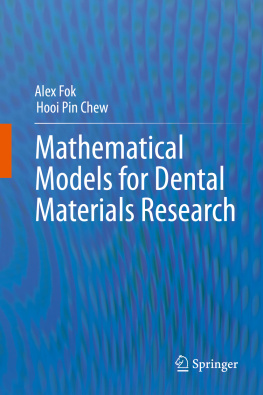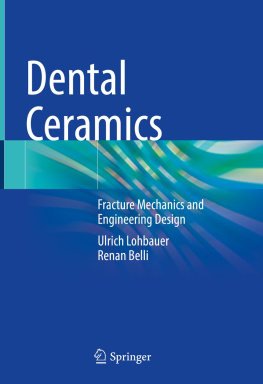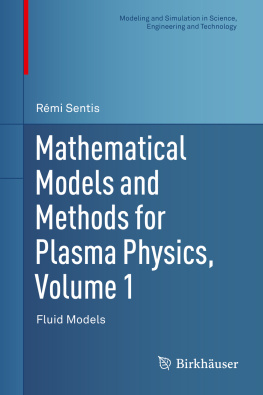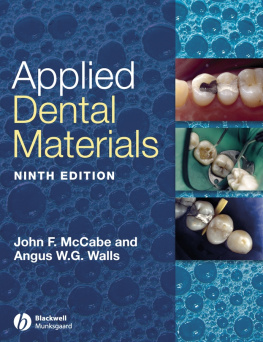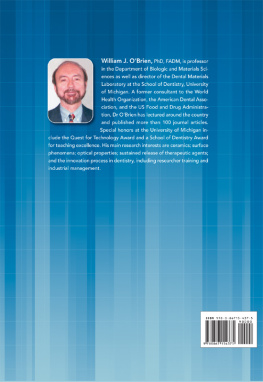Alex Fok - Mathematical Models for Dental Materials Research
Here you can read online Alex Fok - Mathematical Models for Dental Materials Research full text of the book (entire story) in english for free. Download pdf and epub, get meaning, cover and reviews about this ebook. year: 2020, publisher: Springer International Publishing, genre: Children. Description of the work, (preface) as well as reviews are available. Best literature library LitArk.com created for fans of good reading and offers a wide selection of genres:
Romance novel
Science fiction
Adventure
Detective
Science
History
Home and family
Prose
Art
Politics
Computer
Non-fiction
Religion
Business
Children
Humor
Choose a favorite category and find really read worthwhile books. Enjoy immersion in the world of imagination, feel the emotions of the characters or learn something new for yourself, make an fascinating discovery.
- Book:Mathematical Models for Dental Materials Research
- Author:
- Publisher:Springer International Publishing
- Genre:
- Year:2020
- Rating:3 / 5
- Favourites:Add to favourites
- Your mark:
- 60
- 1
- 2
- 3
- 4
- 5
Mathematical Models for Dental Materials Research: summary, description and annotation
We offer to read an annotation, description, summary or preface (depends on what the author of the book "Mathematical Models for Dental Materials Research" wrote himself). If you haven't found the necessary information about the book — write in the comments, we will try to find it.
Alex Fok: author's other books
Who wrote Mathematical Models for Dental Materials Research? Find out the surname, the name of the author of the book and a list of all author's works by series.
Mathematical Models for Dental Materials Research — read online for free the complete book (whole text) full work
Below is the text of the book, divided by pages. System saving the place of the last page read, allows you to conveniently read the book "Mathematical Models for Dental Materials Research" online for free, without having to search again every time where you left off. Put a bookmark, and you can go to the page where you finished reading at any time.
Font size:
Interval:
Bookmark:
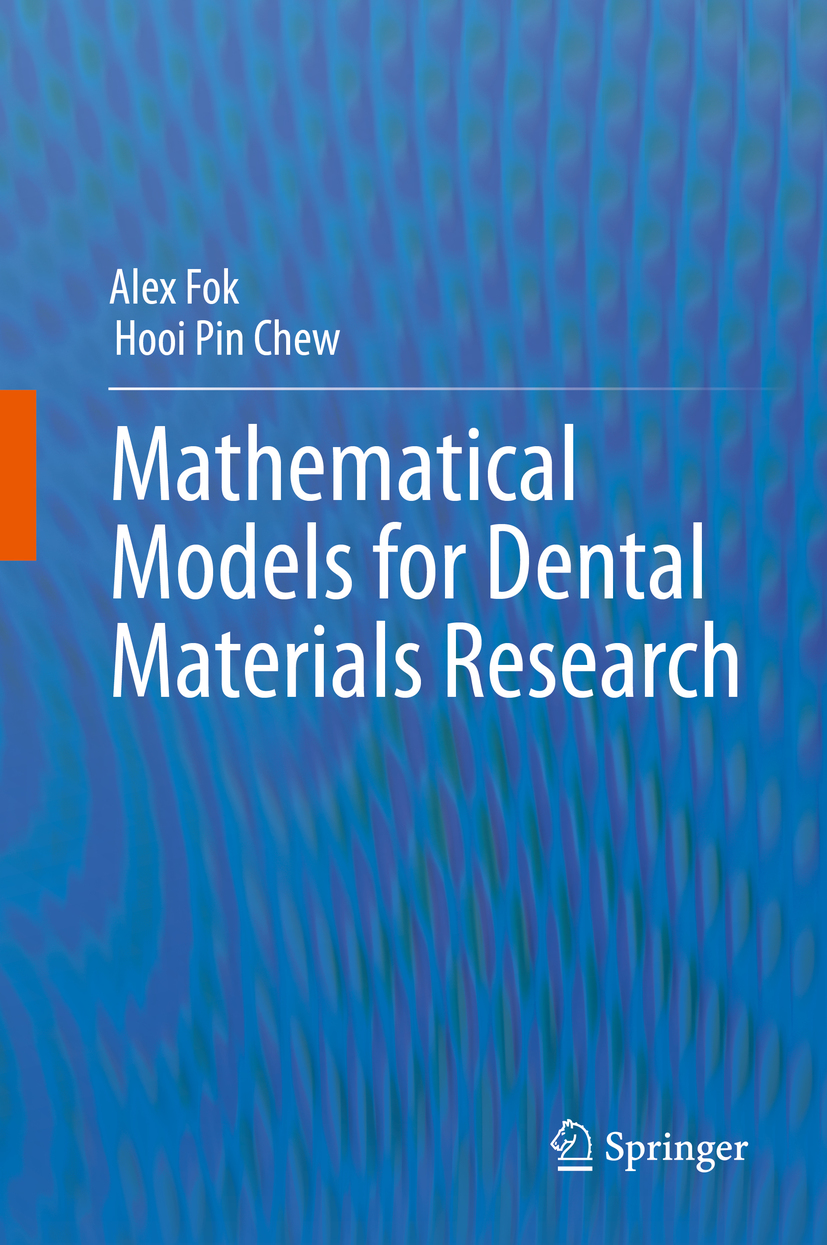

This Springer imprint is published by the registered company Springer Nature Switzerland AG
The registered company address is: Gewerbestrasse 11, 6330 Cham, Switzerland
I had the feeling that, through the surface of atomic phenomena, I was looking at a strangely beautiful interior, and felt almost giddy at the thought that I now had to probe this wealth of mathematical structures nature had so generously spread out before me.
Werner Heisenberg, quantum physicist
I am truly glad to write this Foreword toMathematical Models for Dental Materials Research. Writing gives me the opportunity to say something more general about mathematics as well as to endorse the content produced by two highly competent colleagues: Dr. Alex Fok and Dr. Hooi Pin Chew.
Mathematics has played a significant role throughout human history being closely intertwined with science, engineering and technology, plus its intellectual ties with philosophy and theology. Mathematics is for all. The popularity of Sudoku is evidence that a wide range of people can enjoy mathematics. Unfortunately, many intelligent people have had bad experiences with their mathematical education. This was my own experience during much of my high school education. What passed for teaching largely reduced to repetitive exercises and attempting to solve problems with insufficient explanation of the underlying theory or rationale. It was only when I went to university, studying mathematics alongside major courses in physics and chemistry, that light dawned! Professional mathematicians at university taught the mathematics courses. They developed the underlying theories systematically and logically. I flourished under that regime and continued to seek out mathematical treatments of phenomena in physics, chemistry and materials science. My most successful research paper ever, from my Ph.D., would have been impossible without good mathematical understanding.
I began to see that mathematics is not only understandable and useful but also intellectually rewarding and beautiful. Especially when freed from the artificial constraints of examinations and competition, mathematics can be an engaging and intellectually satisfying pastime, with unexpected relevance to normal life [1].
My philosophyor theologyof science is based on the concept oftheistic creation.This embodies the view that Mind is antecedent to Matter and that created reality has a real existence susceptible to exploration and discovery by human beings [2]. A popular alternative view (reductive materialism) envisages mind as being merely a highly organized state of matter that has arisen by purposeless processes or chance. It is questionable whether this view is internally coherent, as has been recognized recently by the leading philosopher, Thomas Nagel [3]. A corollary of that view is that mathematical structures aremerelyinventions of the human mind imposing order on a fundamentally chaotic universe. The theistic view, akin to philosophicalidealism, holds that mathematical structures exist out there and awaitbothhuman discoveryandimportant elements of human development/invention [4]. This would explain why appropriate mathematical models are capable of forming such an excellent fit to physical reality. The Nobel Prize winner, Eugene Wigner, expressed his astonishment at the Unreasonable effectiveness of mathematics in the natural sciences [5].
Another key feature of mathematics is its historyat least over the past 3000 years. There are numerous books on the history of mathematics, ranging from the boring to the brilliant. Supplementing these is a superb website maintained by the University of St Andrews: theMacTutor History of Mathematics archive: ( http://www-history.mcs.st-and.ac.uk/ ). This brings out the essential human dimension and the astonishing achievements of mathematicians such as Leonhard Euler (17071783), the Swiss mathematician, physicist, astronomer, geographer, logician and engineer who is now largely unknown to the general public. Euler discovered what is widely regarded as the most beautiful equation in mathematics:

This connects the fivefundamental constantsof mathematics (e,,i, 0, 1), where the imaginary numberiis the square root of 1. It includes the three most importantmathematical operations(addition, multiplication and exponentiation) and includes the constants symbolizingthe four major branches of mathematics: arithmetic (0,1), algebra (i), geometry () and analysis (e). If you have an enquiring mindthe greatest prerequisite for success as a researcherI hope you will think that this is intriguing and worthy of further investigation.
There are several accessible books that can stimulate and motivate an interest in mathematics. David Achesona mathematician at Oxford Universitywrote1089 and All That[6]said by a reviewer to be possibly the nicest maths book ever written! A colleague at Manchester University, Paul Glendinning, wroteMaths in Minutes: 200 key concepts explained in an instant[7]. Each section includes an informative picture and a maximum 200-word explanation. Tony Crilly has written a similar sort of book on50 Mathematical Ideasincorporating more extended discussions, without it reading like a formal textbook [8]. Several other books focus upon famous equations in science, explaining their background and significance [911].
Font size:
Interval:
Bookmark:
Similar books «Mathematical Models for Dental Materials Research»
Look at similar books to Mathematical Models for Dental Materials Research. We have selected literature similar in name and meaning in the hope of providing readers with more options to find new, interesting, not yet read works.
Discussion, reviews of the book Mathematical Models for Dental Materials Research and just readers' own opinions. Leave your comments, write what you think about the work, its meaning or the main characters. Specify what exactly you liked and what you didn't like, and why you think so.

